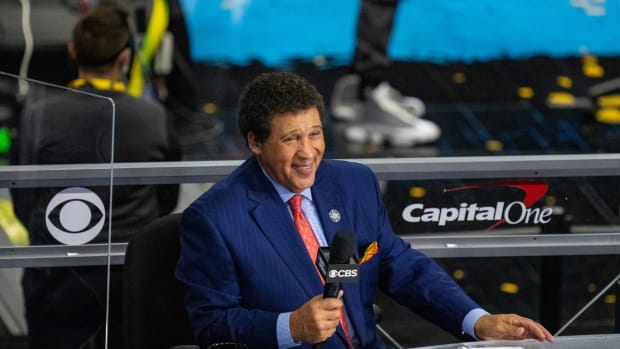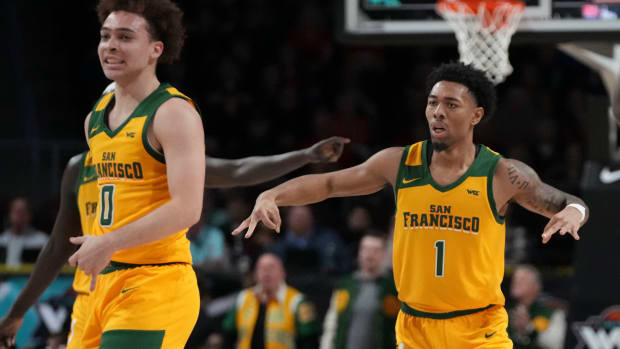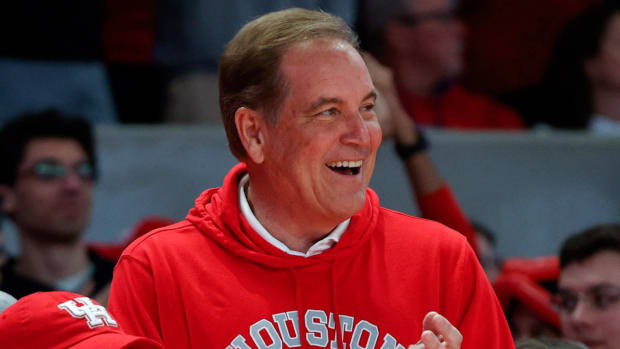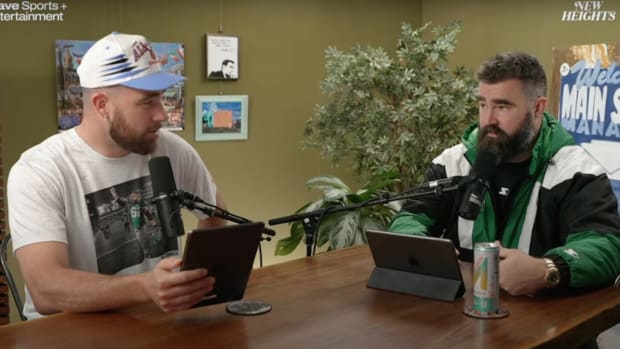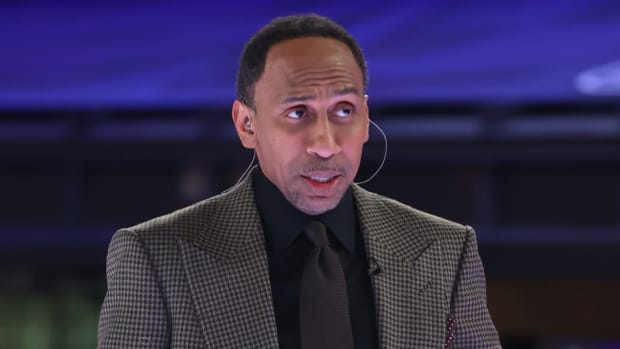Is College Basketball’s ‘Bowl Season’ Actually Good for the Game?
Here is this week’s edition of SCREENSHOTS, a weekly report from the intersection of sports, media, and the Internet.
Welcome to college basketball’s bowl season.
Tuesday, the sport returned as Kansas and Duke beat Michigan State and Kentucky in ESPN’s Champions Classic. That event officially tipped off the season for the first time, which meant competing with election coverage (ESPN VP Nick Dawson said that will happen again in 2022 but not 2020). Still, opening the season is fitting for the Classic, given all of the other Classics that have followed.
In 2014, the CBS Sports Classic was launched with its own quartet of regular participants: Kentucky, UNC, UCLA, and Ohio State. Three years later, the Citi Hoops Classic was born, which will also feature Kentucky and air on Fox. This season, the Jerry Colangelo Classic joins the mix when No. 3 Gonzaga faces No. 6 Tennessee.
Of course, there are still the more classic events too, like the Maui Invitational, which could have its strongest field in its 35-year history this month. Two of its first-round matchups made SB Nation’s list of the Top 50 non-conference games, while more than half of the ranked entries overall came from some sort of showcase, invitational, or interconference challenge series.
There are downsides to these events. To list a few...
• Many of the sponsored titles match the college football postseason for overstuffed corporatization (I can’t imagine the Gotprint.com Legends Classic Presented by Old Trapper aging well).
• Neutral arenas come devoid of one of college basketball’s best elements. “There’s nothing better than a college basketball game played on-campus in terms of the environment,” Dawson said. “You aren’t going to match that at a neutral venue.”
• Freshman-filled teams often aren’t clicking so early in the year, and the games rarely have truly significant stakes.
• Mid-majors can get left out of the action.
• Also, without getting sidetracked: the players should be better compensated for their role in all of this.
But I can get past those issues, because the games are good. A focus on spectacle earlier this decade—24 hours of hoops, games on aircraft carriers, etc.—has given way to networks drawing interest with compelling matchups and big brands. Altogether, college basketball’s non-conference slate might represent the single clearest case of today’s fractured, money-focused media environment producing a win for fans.
Television’s fight to attract younger audiences has been well documented, and college coaches trying to get through to the Instagram generation of recruits can sympathize. Competing with college football’s continued growth as well as every other possible distraction under the sun, programs have recognized the need to play attention-grabbing games.
RAGATZ: R.J. Barrett Asserts Himself as Duke’s Best Player in Champions Classic Win
Sports networks, meanwhile, are hungry for additional quality content. In many cases, they are launching and operating the basketball events themselves. Wasserman senior vice president Tag Garson explained that those events provide additional income and give broadcasters control over the product, allowing them to woo teams that they won’t have the rights to broadcast during conference play. Those teams, in turn, are jumping at the opportunity.
This year, Fox Sports will air a new four-team tournament in Florida as well as a Thanksgiving Las Vegas Invitational packed with UNC, UCLA, Michigan State, and Texas. “I think it’s our best non-conference schedule that we’ve ever had,” Fox Sports’ vice president for collegiate sports, Derek Crocker, said.
Then there are the fans. Though the college audience is—on average—older than its NBA equivalent, it still includes a higher percentage of young people than the other three major sports. Those viewers are able to keep up with rapidly changing storylines, identify key games, and manage the various channels and platforms each team appears on.
When a staffer told Nevada assistant coach Anthony Ruta that the No. 7 Wolfpack’s game at USC would be on FOX, Ruta assumed there’d been a mistake in communication and that the game was actually on FS1. Instead, his team will play a lead-in to the Big Ten football championship game on Dec. 1. “That’s a huge, huge, huge thing to be able to play on national TV like that,” Ruta said.
As excited as that news made him, though, when Ruta found out that another marquee non-conference game—a Sweet 16 rematch with Loyola Chicago—was slated for ESPNews, he wasn’t worried. “With today’s day and age, with Apple TV and Amazon Fire Stick and whatever it is, if there’s a game and there’s a camera, people will find it,” he said. “Even a few years ago it was tough to find some of these games.” So as he helps build schedules now, Ruta is focused on landing the best games possible, not maximizing the team’s chance of playing on any specific major channel.
Eager teams, ambitious networks, and knowledgeable fans are powering a virtuous cycle as each produce and consume better events to keep up with their peers. On Wednesday, Michigan and Villanova will play in a national championship rematch as part of the Gavitt Tipoff Games. A month later, Gonzaga and North Carolina will run back the 2016 title game in the first half of a home-and-home agreement.
With three of the top NBA prospects, Duke might end up being the biggest draw of all. It could play No. 11 Auburn and No. 3 Gonzaga in Maui, depending on how that tournament develops, and will face Texas Tech in Madison Square Garden to end 2018. By then, the Blue Devils will have made six ESPN appearances, more than LeBron James’s Lakers have on the channel this calendar year.
Elsewhere in college sports news
• Despite the boom in non-conference events, there’s still an unfortunate schedule lull during the season’s first week. NCAA senior vice president for basketball, Dan Gavitt, told Stadium’s Jeff Goodman Tuesday that he’d like to see that remedied. One possible solution could come from the ACC. With the launch of the ACC Network next year, the league is moving from 18 to 20 conference games and reportedly planning to play those extra games in November and December. However, UNC coach Roy Williams has adamantly said that the conference schedule expansion will mean fewer big-time non-conference games for his Tar Heels going forward.
• As part of the Veterans Classic at the U.S. Naval Academy Friday, CBS Sports Network will air a feature on John McNamara, the sportswriter who was killed in this summer’s Capital Gazette shooting in Annapolis. The University of Maryland, which will play Navy at 8:30 p.m. that night, has already set up a scholarship in McNamara’s name.
• Fox Sports is bringing back its “all-access” telecast for a second men’s basketball game this year, presenting Seton Hall at Butler without commercials and with both teams’ coaches wearing live microphones on Feb. 2.
• In its inaugural year, ESPN+ will include nearly 3,000 games with a schedule to be announced weekly. “We are excited to learn,” Dawson said. “You have some educated ideas of what content might work and what might not work but you don’t really know until you go through it.” On the linear channels, Dawson said ESPN has worked to get more flexibility from its content partners so it can swap in different games as storylines emerge, more like how it handles its college football schedule. Something to watch as the season progresses.
Checking Out Vice Sports’ Path
The Wall Street Journal reported Wednesday that Vice Media has instituted a hiring freeze amid expectations that its annual revenue will fall below previous projections. The story also includes Chief Executive Nancy Dubuc’s reported plan for the future, including pushing its in-house advertising agency and offering multimedia production for third parties. That direction sounds a lot like the path Vice Sports has taken since laying off staff members and focusing on video in 2017.
This fall, Vice Sports released a five-episode documentary series, The Way We Ball, about basketball around the world, which came as part of a multi-year partnership agreement signed with the NBA months after that 2017 change in strategy. The NBA funded the production and provided access to its archives and athletes, trusting Vice to reach young fans around the world.
Vice Sports director of video Dan Bradley knew episode one would be a hit. It featured Joel Embiid. “With him, on the internet you’re guaranteed to do pretty well,” Bradley said. But episode two focused on basketball culture in China, a particularly risky subject given that the videos wouldn’t be easily accessible in the country. “It was something that kept me up at night beforehand,” Bradley said. “I’m always a little worried about breaking through.” That feature proved to be the season’s most popular, with nearly 500,000 views on YouTube. Bradley said the average watch time for the 25-minute documentary is around 15 minutes, and that for the season overall, 40 percent of the viewership has come from outside of the U.S. Across platforms like Snapchat, Instagram, and Facebook, the series has garnered 15 million views.
The Way We Ball’s most distinctive feature is the voice-over, provided by New York rapper A$AP Twelvyy. As for broadcasting the production’s ties to the league, Bradley said Vice is “constantly evolving with the whole industry.” For now, the formula involves showing the NBA’s logo after each episode’s title.
Bradley spoke to SI before the Wall Street Journal report was made public. Later, a Vice Sports source said that it’s unclear how the vertical will be affected, but as of yet there have been no changes to its production timeline. In the meantime, Bradley believes there’s room for companies to produce engaging longform content for brands beyond the social videos the NBA creates in-house and the slick 30-second spots advertisers can put together. On YouTube, the NBA’s daily highlights video often gets 500,000 views itself.
Next week, Vice Sports will debut its next series, a six-episode run of sports crime stories. The project came out of a partnership with Verizon-owned RYOT.
Controversial Ads During NFL Games Could Be the New Normal
The battle over politics’ place in sports has spilled over into the commercial breaks. The most discussed element of the Patriots and Packers’ Sunday Night Football showdown was the political immigration ad that ran during the contest after CNN refused to broadcast it and called it “racist.” NBC later decided it would not show the spot again.
“After further review we recognize the insensitive nature of the ad and have decided to cease airing it across our properties as soon as possible,” the network said in a statement.
The NFL also made an announcement, saying the league “played no role in the airing of the spot last night.… The NFL has no approval rights regarding campaign ads. That falls to the network that is selling the advertising and airing the game.”
Earlier this season, it was the Colin Kaepernick-voiced Nike ad that stole the show during NBC’s season-opening telecast. In between, viewers were bombarded by political ads from across the spectrum during this election season. Sports broadcasters often boast about games’ sustained ability to retain live viewers in a rapidly changing marketplace. But that has also made the telecasts an attractive destination for agenda-driven advertisers, as NBC itself reported earlier this fall.
"The ability to get your message through to anyone—voters, consumers or anything like that—has become far more difficult as the media landscape fractures," Republican media consultant Casey Phillips said in the piece. “Live sports has always been a great place to target people.”
SIGHTLINES
News and notes from across the sports media landscape
• The NBA will televise its playground-style All-Star draft for the first time this year, according to The New York Times’ Marc Stein and Kevin Draper. The broadcast will likely air on TNT in late January.
"When we sat with the union and we came up with this format, we all agreed, let's not turn something that's 100 percent positive into a potential negative to any player," commissioner Adam Silver said last year. "But then ... maybe we're overly conservative, because then we came out of there, and the players were, 'We can take it. We're All-Stars. Let's have a draft.' So it sounds like we're going to have a televised draft next year."
• The Ringer’s Kevin Clark spent a Sunday with rules analyst Mike Pereira and charted the growth of what Troy Aikman called a “cottage industry.”
• Saturday night, Notre Dame hosts Florida State 25 years after the two played the highest-rated regular season college football game on record. To celebrate, NBC Sports published Bob Costas’s open to that broadcast.
• The New York Post’s Andrew Marchand reported this week that Fox is working towards a World Series extension with MLB.
• Brian Steinberg got some great information on how in-game advertising is changing during NFL broadcasts.
• On The Athletic, Richard Deitsch has the story of the first female lead producer for an NFL game since the 1990s.
• Major League Soccer said that its move to Twitter from Facebook Live for streaming games came with a doubling of its audience. Adweek has more details on the league’s growth.
• ESPN has announced a new slate of Snapchat programming featuring Stephen A. Smith, Rachel Nichols, Mike Greenberg and others.
THANK YOU, INTERNET…
…for discovering that, sometimes, it’s quite difficult to tell Bears coach Matt Nagy and Bears offensive coordinator Mark Helfrich apart.
